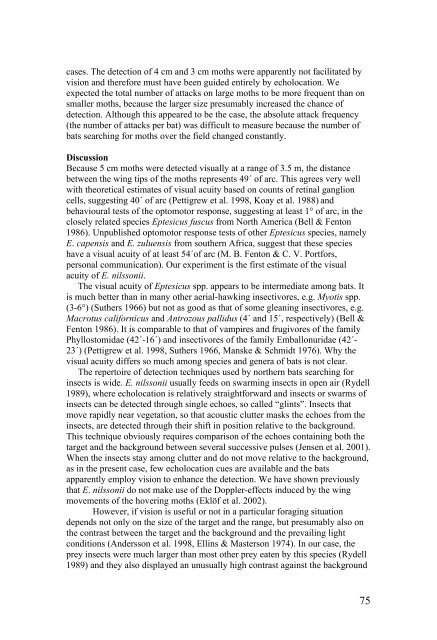Vision in echolocating bats - Fladdermus.net
Vision in echolocating bats - Fladdermus.net
Vision in echolocating bats - Fladdermus.net
Create successful ePaper yourself
Turn your PDF publications into a flip-book with our unique Google optimized e-Paper software.
cases. The detection of 4 cm and 3 cm moths were apparently not facilitated by<br />
vision and therefore must have been guided entirely by echolocation. We<br />
expected the total number of attacks on large moths to be more frequent than on<br />
smaller moths, because the larger size presumably <strong>in</strong>creased the chance of<br />
detection. Although this appeared to be the case, the absolute attack frequency<br />
(the number of attacks per bat) was difficult to measure because the number of<br />
<strong>bats</strong> search<strong>in</strong>g for moths over the field changed constantly.<br />
Discussion<br />
Because 5 cm moths were detected visually at a range of 3.5 m, the distance<br />
between the w<strong>in</strong>g tips of the moths represents 49´ of arc. This agrees very well<br />
with theoretical estimates of visual acuity based on counts of ret<strong>in</strong>al ganglion<br />
cells, suggest<strong>in</strong>g 40´ of arc (Pettigrew et al. 1998, Koay et al. 1988) and<br />
behavioural tests of the optomotor response, suggest<strong>in</strong>g at least 1° of arc, <strong>in</strong> the<br />
closely related species Eptesicus fuscus from North America (Bell & Fenton<br />
1986). Unpublished optomotor response tests of other Eptesicus species, namely<br />
E. capensis and E. zuluensis from southern Africa, suggest that these species<br />
have a visual acuity of at least 54´of arc (M. B. Fenton & C. V. Portfors,<br />
personal communication). Our experiment is the first estimate of the visual<br />
acuity of E. nilssonii.<br />
The visual acuity of Eptesicus spp. appears to be <strong>in</strong>termediate among <strong>bats</strong>. It<br />
is much better than <strong>in</strong> many other aerial-hawk<strong>in</strong>g <strong>in</strong>sectivores, e.g. Myotis spp.<br />
(3-6°) (Suthers 1966) but not as good as that of some glean<strong>in</strong>g <strong>in</strong>sectivores, e.g.<br />
Macrotus californicus and Antrozous pallidus (4´ and 15´, respectively) (Bell &<br />
Fenton 1986). It is comparable to that of vampires and frugivores of the family<br />
Phyllostomidae (42´-16´) and <strong>in</strong>sectivores of the family Emballonuridae (42´-<br />
23´) (Pettigrew et al. 1998, Suthers 1966, Manske & Schmidt 1976). Why the<br />
visual acuity differs so much among species and genera of <strong>bats</strong> is not clear.<br />
The repertoire of detection techniques used by northern <strong>bats</strong> search<strong>in</strong>g for<br />
<strong>in</strong>sects is wide. E. nilssonii usually feeds on swarm<strong>in</strong>g <strong>in</strong>sects <strong>in</strong> open air (Rydell<br />
1989), where echolocation is relatively straightforward and <strong>in</strong>sects or swarms of<br />
<strong>in</strong>sects can be detected through s<strong>in</strong>gle echoes, so called “gl<strong>in</strong>ts”. Insects that<br />
move rapidly near vegetation, so that acoustic clutter masks the echoes from the<br />
<strong>in</strong>sects, are detected through their shift <strong>in</strong> position relative to the background.<br />
This technique obviously requires comparison of the echoes conta<strong>in</strong><strong>in</strong>g both the<br />
target and the background between several successive pulses (Jensen et al. 2001).<br />
When the <strong>in</strong>sects stay among clutter and do not move relative to the background,<br />
as <strong>in</strong> the present case, few echolocation cues are available and the <strong>bats</strong><br />
apparently employ vision to enhance the detection. We have shown previously<br />
that E. nilssonii do not make use of the Doppler-effects <strong>in</strong>duced by the w<strong>in</strong>g<br />
movements of the hover<strong>in</strong>g moths (Eklöf et al. 2002).<br />
However, if vision is useful or not <strong>in</strong> a particular forag<strong>in</strong>g situation<br />
depends not only on the size of the target and the range, but presumably also on<br />
the contrast between the target and the background and the prevail<strong>in</strong>g light<br />
conditions (Andersson et al. 1998, Ell<strong>in</strong>s & Masterson 1974). In our case, the<br />
prey <strong>in</strong>sects were much larger than most other prey eaten by this species (Rydell<br />
1989) and they also displayed an unusually high contrast aga<strong>in</strong>st the background<br />
75


